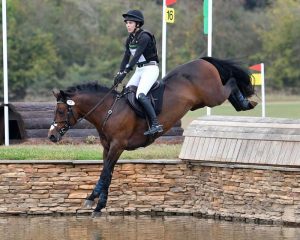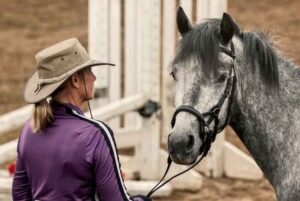Connemara ponies were first brought to the United States in the 1950’s, primarily as children’s riding ponies. The American Connemara Pony Society (ACPS) was formed in 1956. Most other countries with imported Irish ponies conducted inspections, and the idea of inspecting ponies for inclusion in a Stud Book in the U.S. was adopted for the first years. Members of the newly formed ACPS acted as Inspectors.
But, with a growing population of Connemara ponies, and a vast country, the practice was slowly abandoned so that for many years there were no inspections in our country.
International Committee of Connemara Pony Societies is Founded
In 1988 an event that would provide the impetus for renewing inspections in the U.S. occurred. The International Committee of Connemara Pony Societies, (ICCPS), was founded during a meeting of Overseas Societies in Clifden, Ireland. The CPBS was given a mandate to draft proposals for a set of International Rules governing all recognized Connemara Pony societies.
The initial intent was to comply with European Union regulations, but it was quickly realized that a global organization would benefit the breed world-wide. The objective of this “harmonization” effort was to create an environment throughout the world to encourage continued positive development of this ancient breed without losing sight of its remarkable, hardy, native characteristics.
These rules comply with European Union zootechnical legislation and facilitate the registration and movement of ponies worldwide. Presently, international representatives continue to meet annually in Clifden, Ireland. Although the ACPS became an affiliated member of the ICCPS, interest in becoming an Approved member stimulated an in-depth investigation into the practicalities of inspections (which were a requirement for Approved status) in the United States.
The ACPS Inspection Committee is Formed
In 1990, meetings were initiated to determine the extent of membership interest in ultimately joining the ICCPS. Surveys were sent to members requesting their comments and concerns pertaining to the possibility of establishing an ACPS inspection program. Building upon a great deal of positive feedback, an ACPS Inspection Committee was formed and began working on the development of policies and procedures to use in the inspection of ponies here in America.
Many, many ideas were considered and incorporated. Forms were written and re-written. Sound inspection policies evolved, utilizing the input of literally dozens of people, meeting dozens of times. A numerical system of judging was suggested, but ultimately rejected.
Also suggested was a way to “grade” the ponies into categories of Excellent, Good, and Average, with different color seals suggested for each category. This idea was also rejected as being too divisive. In fact, the guiding principles used by the Inspection Committee were inclusiveness and fairness.
Furthermore, it was hoped that by maintaining and working through an Inspection Program, breeders would be encouraged and educated, and the ACPS would better ensure the accurate identification and preservation of the Connemara breed type in America.
There were a few ACPS members that worried that Connemara ponies not adhering strictly to the Irish type would not be approved, even though they descended from registered Connemara stock and had been purchased as Connemara ponies. There was also some concern expressed about limiting the gene pool.
However, the majority of ACPS members were in favor of the suggested “voluntary” inspection program developed and offered by the Society with its goals of preserving the distinguishing and noteworthy characteristics of the Connemara Pony, its calm demeanor and intelligent, tractable temperament, while adhering to the written breed standard.
First Inspections
The first inspections were conducted by the president of the CPBS, Eamonn Hammon, and his colleague, Dermot Power. American inspectors acted as team members, learning how the Irish Inspectors evaluated ponies and sharing ideas of how best to communicate the need for an honest appraisal of breeding stock.
The Irish both taught and evaluated the ability of the Americans to inspect their own stock. Irish, or on one occasion, British inspectors were present at yearly inspections, often in conjunction with the ACPS Annual Meeting, until 2003, when a remote meeting site with only a few ponies to be inspected made an overseas inspector impractical.
The ACPS Stud Book is Established
In 2001, it was decided to establish an ACPS Stud Book listing inspected and approved ponies, separate from the ACPS Registry. This “two-tiered” system thus brought the ACPS closer to meeting all of the criteria for Approved membership status in the ICCPS.
By 2004, the ACPS had been holding voluntary inspections for 10 years. A Stud Book composed of only inspected and approved ponies had been established.
The ACPS Board of Governors also approved the following policy regarding registrations and inspections:
“All purebred Connemara ponies in the United States are eligible to be entered in the ACPS Registry. Purebred Connemara mares and stallions which have been inspected and approved will be entered in the ACPS Stud Book.”
Thus, the Stud Book is composed of approved, registered stallions and mares, and the Registry accommodates foals before inspection, geldings, and non-Stud Book mares and stallions.
A very important part of the policy, one that takes into account the large area of the country, and the probability that there will be ponies who can’t practically be inspected, is:
“IF AN UNAPPROVED (OR UNINSPECTED) MARE OR STALLION PRODUCES OFFSPRING, THAT OFFSPRING WILL BE ELIGIBLE FOR INSPECTION. IF THE OFFSPRING IS APPROVED AT INSPECTION THAT OFFSPRING WOULD THEN BE INCLUDED IN THE STUD BOOK.”
Another important provision is that ponies may be officially measured at 2 years of age by a licensed equine veterinarian. At any time, pony owners may then submit with their application for inspection, a signed affidavit of the two-year-old measurement. This provision was added as many ponies are not inspected until they are 3, 4, 5, or older.
In 2004, with these policies established, the ACPS requested Approved status in the ICCPS. In September of 2005, a letter from CPBS President, Tom MacLochlainn, was received, granting the ACPS Approved membership status in the ICCPS.
Thus, individuals who want to have their ponies included in the ACPS Stud Book, assuring that their ponies conform to a world-wide standard, may have their ponies inspected.
Ponies bred in countries that are members of the European Union, England, Canada, Australia, and New Zealand and inspected in those countries prior to export do not need to be reinspected in the United States but they do need to be ACPS registered.
Ponies who are not inspected or not approved may still be registered with the ACPS and can be bred. Their offspring are fully eligible for inspection and, if approved, would be included in the Stud Book.






